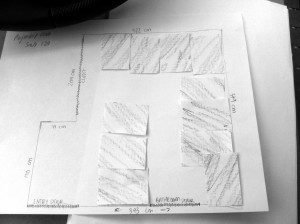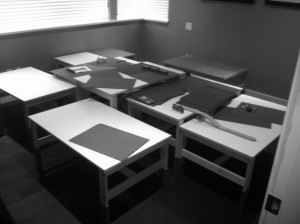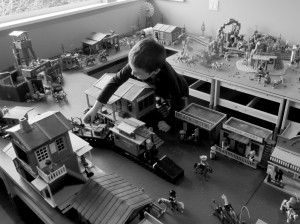Building Play Worlds
There are lots of ways to assemble play worlds using different toys and play systems. What we’ve compiled here are just the techniques we happened to have developed and the steps we followed to build what is shown in the galleries. The most important consideration for us was that we were building play worlds that were both realistic and functional. Even though the gallery photos depict specific scenes and make the play worlds look somewhat like dioramas, on an average day when a given play world is in use, everything looks much different.
Here are the materials we use:
- Small modular tables that are height-adjustable (We use the “SANSAD” tables from IKEA® but any children tables should work as long as they are the same height and shape.)
- Different colored yoga mats (We use “The Big Mat” from lululemon athletica® because it has a matte surface finish that lends itself well to keeping figures and other play elements in place.)
Here are the basic steps we follow:
- Plan the play world room layout by measuring the walls and sketching a floor plan. Create cut outs that match the dimensions and quantity of the tables that are available for use in the play world room. Think about whether the play world surface should be continuous or whether parts of it should be disconnected from others. Arrange the cut outs in the layout accordingly. Ensure that the planned layout will be functional so that children and adults can easily walk around and share the playing surfaces. No one surface should be so deep that a child is unable to reach from one side to the other.
- Take a best guess as to how the play world will be partitioned into different types of surface colors. Based on the nature of the play world, choose mats or surfaces that provide the most suitable base colors. For example, green or brown for landscape surfaces, blue for water, black for an airport runway or even outer space.
- Cut the mats according to what was decided in the previous step. Ideally, match the mats to individual table dimensions instead of allowing mats to span tables. This way, the tables can be more easily moved if the room layout needs to be reconfigured later on. (The types of scissors required to cut yoga mats will need to be very sharp. Therefore, for obvious safety reasons, do not let children participate in this step.)
- After the tables and mats have been cleaned, start assembling the individual parts of the play world regions. Try to build kits that relate to the same region first so that children can start playing with that part of the play world before other parts are ready.
The best part of this process is that, with the exception of Step #3, most tasks can usually be completed by a team comprised of adults and kids. Having children participate in the planning and construction of the play world layout, in addition to building the actual toy play sets, can help foster a basic understanding of engineering.
Learning with Play Worlds
It’s important to understand that these building projects are not about buying large quantities of toys for kids. They are about using available toy systems as something tangible to help realize ideas and foster creativity, and to also learn about the practical considerations and requirements that can come with attaining these realizations. Once a play world is in place, the potential scope of play activity is much broader and more educational than when children play with individual toys. Depending on the nature of a play world, play activity can generate some genuine opportunities for learning basic life concepts.
For example:
- Commerce and Trade – Requiring characters to maintain and acquire funds or goods for barter in order to obtain items and supplies.
- Supply and Demand – Having limited inventory or resources and obtaining more when required.
- Supply Chain – Showing how goods are made or gathered and how they are then transported via different methods to arrive at a destination where they are made available to consumers.
- Conflict Resolution and Diplomacy – Overcoming problems or threats through mediation or creative thinking.
- Strategy – Determining ways to overcome obstacles or opponents to achieve specific goals.
- Cultural Diversity – Gaining an appreciation for how the history, traditions and customs of different regions and communities can vary.
- Politics – Activities of a ruling body, such as a mayor, king, emperor or community leader and alliances among kingdoms, governments or factions.
- Rules and Parameters – Respecting and working within certain rules or limitations that may be specific to some regions due to culture, ruling authorities, environmental characteristics, etc.
The context of a given play activity can shift when it takes place in a different play world region and is subject to distinct circumstances. It’s great to see how a range of scenarios can challenge kids to plan, adapt and be creative.


